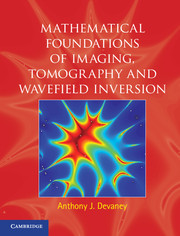Book contents
- Frontmatter
- Contents
- Preface
- 1 Radiation and initial-value problems for the wave equation
- 2 Radiation and boundary-value problems in the frequency domain
- 3 Eigenfunction expansions of solutions to the Helmholtz equation
- 4 Angular-spectrum and multipole expansions
- 5 The inverse source problem
- 6 Scattering theory
- 7 Surface scattering and diffraction
- 8 Classical inverse scattering and diffraction tomography
- 9 Waves in inhomogeneous media
- 10 Time-reversal imaging for systems of discrete scatterers
- 11 The electromagnetic field
- Appendix A Proof of the scattering amplitude theorems
- Appendix B Derivation of the generalized Weyl expansion
- References
- Index
8 - Classical inverse scattering and diffraction tomography
Published online by Cambridge University Press: 05 July 2012
- Frontmatter
- Contents
- Preface
- 1 Radiation and initial-value problems for the wave equation
- 2 Radiation and boundary-value problems in the frequency domain
- 3 Eigenfunction expansions of solutions to the Helmholtz equation
- 4 Angular-spectrum and multipole expansions
- 5 The inverse source problem
- 6 Scattering theory
- 7 Surface scattering and diffraction
- 8 Classical inverse scattering and diffraction tomography
- 9 Waves in inhomogeneous media
- 10 Time-reversal imaging for systems of discrete scatterers
- 11 The electromagnetic field
- Appendix A Proof of the scattering amplitude theorems
- Appendix B Derivation of the generalized Weyl expansion
- References
- Index
Summary
The “direct” or “forward” scattering problem was treated in the preceding two chapters, where the goal was the computation of a scattered field given knowledge of the scattering object and the incident wavefield. In the “inverse scattering problem” (ISCP) the goal is the determination of the scattering object given knowledge of the incident wave and the scattered wave over some restricted region of space. In Chapter 6 we treated so-called “penetrable” scatterers, where the incident wave penetrates into the interior of the obstacle, thus creating an “induced volume source” that then radiates as a conventional volume source of the type treated in earlier chapters. In Chapter 7 we treated non-penetrable scatterers, where the interaction of the incident wave with the obstacle occurs only over the object's surface. We also treated certain inverse problems associated with non-penetrable scatterers in that chapter that included inverse diffraction and the ISCP of determining the shape of a Dirichlet or Neumann scatterer from its scattering amplitude. In this chapter we will treat the ISCP for penetrable scatterers. We will also make the simplifying assumption that the scattering object is embedded in a uniform lossless medium. This assumption will be discarded in the next chapter, where we will treat scatterers embedded in non-uniform and dispersive media.
We pointed out in Chapter 5 that the difficulty of the “inverse source problem” (ISP) lies in the fact that the radiated field from which the source is to be determined is known only over space points that lie in some restricted region of space that is outside the support of the (unknown) source.
- Type
- Chapter
- Information
- Publisher: Cambridge University PressPrint publication year: 2012
- 1
- Cited by



